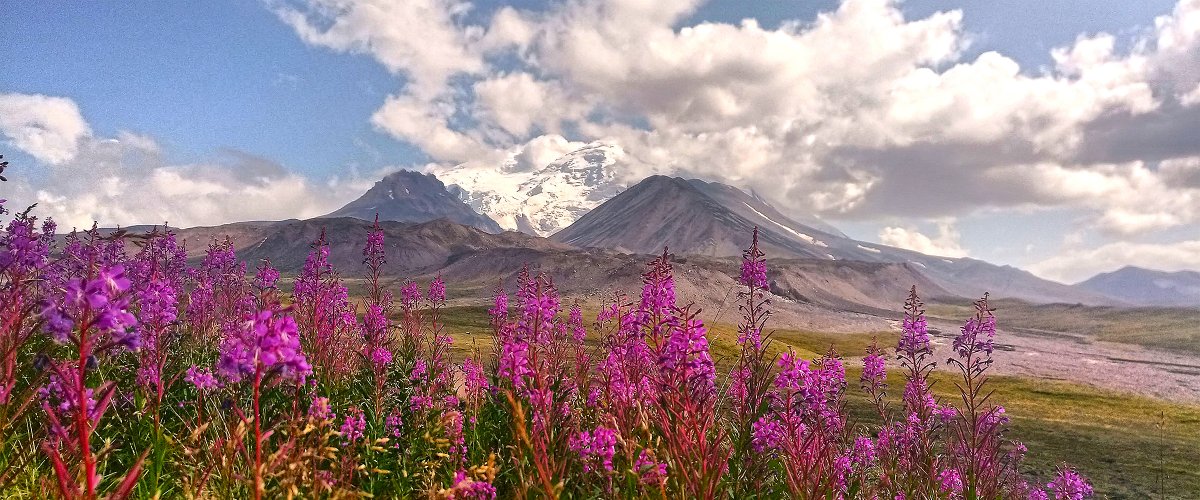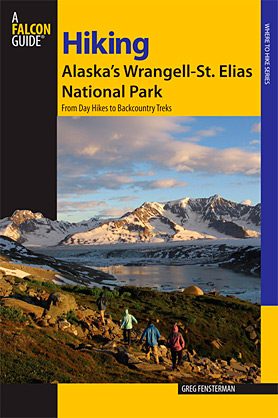
The Chugach, Wrangell, and St. Elias mountain ranges converge in Wrangell St. Elias National Park, what is often referred to as the "mountain kingdom of North America." The largest unit of the National Park System and a day's drive east of Anchorage, Wrangell St. Elias National Park includes the continent's largest assemblage of glaciers and the greatest collection of peaks above 16,000 feet.
Mount St. Elias, at 18,008 feet, is the second highest peak in the United States. Adjacent to Canada's Kluane National Park, the site is characterized by remote mountains, valleys, wild rivers, and a variety of wildlife.
McCarthy is the primary gateway to the interior of Wrangell St Elias National Park and can be reached via the McCarthy road from Chitina. The McCarthy road follows the old road bed of the railroad that once served McCarthy and Kennicott.
The park is a paradise for hiking, backpacking, photography and other wilderness activities. The Kennicott Mine historical area is just five miles up a gravel road from McCarthy.
Early Days: Before Wrangell St. Elias National Park was a Park
It was the lure of riches in the ground that drew the first pioneers to what is now the McCarthy/Kennicott area in the heart of Alaska's Wrangell St. Elias National Park. But not just gold - it was copper, and lots of it, that put the area on the map. In 1899 gold was discovered near the headwaters of the Nabesna River in what is now the north of Wrangell St. Elias National Park. It was a good year for mineral exploration in the area because Oscar Rohn also found copper ore samples in the Kennicott glacial moraine that would later lead to the discovery of rich copper deposits on Bonanza Ridge. Production didn't get into full swing until 1911 when a railroad was completed that reached from Kennicott almost 200 miles to Cordova. Ore was transported by rail to Cordova and from there by barge to Tacoma, Washington where it was smelted.
Kennicott was a classic company town. Most of the miners lived there in company housing and everything revolved around the mining operations. McCarthy quickly developed five miles down the road as a support community to the company town. McCarthy provided many services not available in Kennicott including hotels, hospital, shops, school, photographer's studio, brothels and perhaps most importantly of all, saloons.
By 1938 the rich copper deposits were depleted and the mines of Kennicott as well as the railroad, ceased operations. For a while things were pretty quiet though there were always some people living in the area that would one day become Wrangell St. Elias National Park. During the 1970s tourism began to develop in the region and has continued to grow steadily to the present day.
It was the copper strike that gave birth to McCarthy/Kennicott and indeed Wrangell St. Elias National Park itself, and the effects of those origins are felt today. Kennicott is still a company town of sorts, only now the company is the Park Service instead of the Kennicott Mining Company. And Kennicott is still saloon-less. The bordellos are gone, but McCarthy is still the center of social and nightlife in the area - such as it is.
Eventually the railroad was torn up and the rail bed became the foundation of what is now the McCarthy Road which remains the only road into the interior of Wrangell St. Elias National Park. But the road has a way of reminding visitors of its origin as old nails and spikes from the railroad days work their way up to the surface and into the tires of travelers.
Though it would take decades to come to fruition, the first seeds that would lead to the creation of Alaska's Wrangell St Elias National Park were sown almost as soon as the last train pulled out of Kennicott.
Designation of Wrangell St. Elias as a National Park
The first person to make a recommendation for protected status for the area, was Ernest Gruening, Director of U.S. Territories when he suggested national park or monument status for the region. After visiting the area in 1938, he wrote a memorandum to the Secretary of the Interior:
The region is superlative in its scenic beauty and measures up fully and beyond the requirements for its establishment as a National Monument and later as a National Park. It is my personal view that from the standpoint of scenic beauty, it is the finest region in Alaska. I have traveled through Switzerland extensively, have flown over the Andes, and am familiar with the Valley of Mexico and with other parts of Alaska. It is my unqualified view that this is the finest scenery that I have ever been privileged to see.
It wasn't until 1978 that the area was designated as a National Monument and 1979 when it was designated as a World Heritage Site. The following year, 1980 President Jimmy Carter designated 13.2 million acres as Wrangell St. Elias National Park and Preserve.
Historical Data - Wrangell St. Elias National Park
- Proclaimed as Wrangell St. Elias National Monument - Dec. 1,1978
- Established as a national park and preserve - Dec. 2, 1980.
- Wilderness designated - Dec. 2, 1980.
- Designated a World Heritage Site - Oct. 24,1979.
- Kennecott Mines National Historic Landmark - June 23, 1986
- Valdez Trail -- Copper Bluff Segment - February 12, 1998
- Malaspina Glacier National Natural Landmark
- Chisana Historic Mining Landscape - May 14, 1998
- Bremner Historic Mining District - June 15, 2000
Today Wrangell St Elias National Park is known for hiking and backpacking offering an endless vareity of country and routes easy to ultra-challenging.
